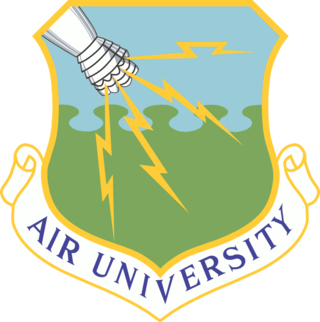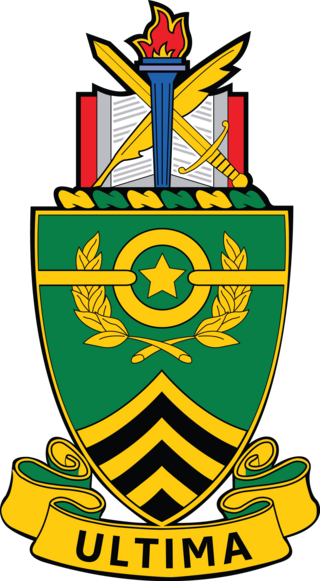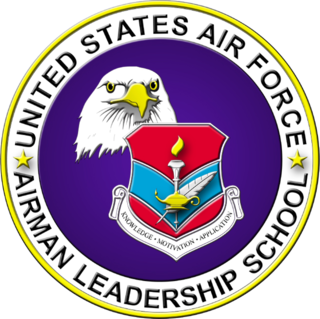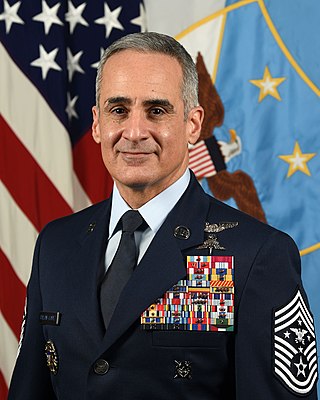
A non-commissioned officer (NCO) is a military officer who does not hold a commission. Non-commissioned officers usually earn their position of authority by promotion through the enlisted ranks. In contrast, commissioned officers usually enter directly from a military academy, officer training corps (OTC) or reserve officer training corps (ROTC), or officer candidate school (OCS) or officer training school (OTS), after receiving a post-secondary degree.
An Arabic numeral device or numeral device sometimes called an "award numeral", is a United States Armed Forces service device that may be authorized for wear on specific service ribbons and suspension ribbons of medals. Arabic numeral devices are bronze or gold in color and are 3⁄16 inch in height.

The U.S. military issues instructor badges to specially training military personnel who are charged with teaching military recruits the skills they need to perform as members of the U.S. Armed Forces or teach continuing education courses for non-commissioned officers and officers in the military. With the exception of the U.S. Army and U.S. Coast Guard, these badges are considered temporary military decorations and must be surrendered upon completion of one's duty as a military instructor. Because of this, the U.S. Air Force, U.S. Navy and U.S. Marine Corps award Drill Instructor Ribbons as a permanent decoration to recognize service members who have qualified and performed as military instructors.

Robert D. Gaylor was an American military senior non-commissioned officer, the 5th Chief Master Sergeant of the U.S. Air Force from 1977 to 1979.

James Mark McCoy was the sixth Chief Master Sergeant of the Air Force, serving from 1979 to 1981.
Specialist is a military rank in some countries' armed forces. Two branches of the United States Armed Forces use the rank. It is one of the four junior enlisted ranks in the United States Army, above private (PVT), private (PV2), and private first class and is equivalent in pay grade to corporal; in the United States Space Force, four grades of specialist comprise the four junior enlisted ranks below the rank of sergeant.

Air University is a professional military education university system of the United States Air Force. It is accredited by the Commission on Colleges of the Southern Association of Colleges and Schools to award master's degrees.

The United States Army Sergeants Major Academy (USASMA) was established on 1 July 1972 at Fort Bliss, Texas, and began instruction in January 1973. Its curriculum is designed to broaden the student's current knowledge base. This approach differs from the Military Occupational Specialty (MOS) related training at the basic and advanced levels of the Noncommissioned Officer Education System. The prime educational technique employed throughout the course is the small group participatory learning process.

Airman Leadership School (ALS) is a 24 duty day United States Air Force program designed to develop airmen into effective front-line supervisors. It is the first professional military education that enlisted Air Force members encounter. ALS focuses on developing leadership abilities, the profession of arms, and building effective communication. ALS was established in the 1990s, replacing the Non-commissioned Officer (NCO) Preparatory Course and NCO Leadership School.

The Basic Leader Course (BLC), formerly the Warrior Leader Course (WLC) and Primary Leadership Development Course (PLDC), is the first course of study in the US Army noncommissioned officer Professional Development System (NCOPDS). BLC is a month-long course that trains specialists and corporals in the fundamentals of leadership. As of 1 July 2021, all corporals are to have already completed BLC; in the interim those corporals who have not yet completed BLC are reassigned as specialists until they have passed the NCO promotion boards for junior leadership; specialists who have completed BLC and have been recommended for promotion are to wear corporal rank before their recommended promotion.

William Joseph Gainey is a retired United States Army soldier who served as the first senior enlisted advisor to the chairman of the Joint Chiefs of Staff.
The U.S. Army Creed of the Noncommissioned Officer, otherwise known as the Noncommissioned Officer's Creed, and commonly shortened to the NCO creed, is a tool used in the United States Army to educate and remind enlisted leaders of their responsibilities and authority, and serves as a code of conduct. Each branch has their own version, and many have been altered over the years.

All branches of the United States Armed Forces use the general term Enlisted Professional Military Education (EPME) to describe the formal system of education which each branch provides to its enlisted personnel. Each branch has its own system and sequence of courses, with the overall focus on leadership and management. Education generally increases in intensity and level of knowledge as individuals progress in rank and assume broader leadership roles. EPME is distinct from the technical training which service members receive for their Military Occupational Specialty (MOS), Air Force Specialty Code (AFSC), or Navy Rating.

Ramón Colón-López is a retired senior non-commissioned officer of the United States Air Force and a former pararescueman, and served as the 4th Senior Enlisted Advisor to the Chairman (SEAC) from December 13, 2019 to November 3, 2023. In his role as SEAC, Colón-López was the most senior enlisted member of the United States military. In 2007 he was the only Hispanic American among the first six airmen to be awarded the newly created Air Force Combat Action Medal. He served as the Senior Enlisted Leader of United States Africa Command from September 2016 to November 2019.

Raymond F. Chandler III is a former United States Army soldier who served as the 14th Sergeant Major of the Army. He was sworn in on March 1, 2011. Chandler served in all tank crewman positions and has had multiple tours as a troop, squadron and regimental master gunner. He has served in the 1st Infantry Division (FWD), 2nd Infantry Division, 4th Infantry Division, 1st Cavalry Division, 3rd Armored Division, 2nd Armored Cavalry Regiment, 3rd Armored Cavalry Regiment, United States Army Armor School, and the United States Army Sergeants Major Academy. He also served as first sergeant in four different detachments, troops and companies. As a sergeant major, he served as Operations SGM in 1/2 ACR and as CSM in 1/7 Cavalry, 1st Cavalry Division, United States Army Garrison Fort Leavenworth, Kansas and the United States Army Armor School CSM. Chandler was assigned as the United States Army Sergeants Major Academy CSM in December 2007. In June 2009, Chandler became the 19th Commandant of USASMA and the first enlisted commandant in USASMA history.

The I.G. Brown Training and Education Center is a detachment of the Air National Guard Readiness Center and is located at McGhee Tyson Air National Guard Base near Knoxville, Tennessee. The TEC conducts an average of 16 Enlisted Professional Military Education courses and 40 Professional Continuing Education sessions throughout the year. Typically, the TEC accommodates 11,000 service members on campus annually from the Total Force, United States Coast Guard, and partner nation armed forces. TEC also manages the ANG's Warrior Network; a $7 m satellite broadcast enterprise with more than 186 downlink sites, providing training, education and command information nationwide. In addition, the studio and multimedia facilities support ANG video productions, senior leader conferences and general-to-career field-specific training.

James A. Cody is a retired airman of the United States Air Force who served as the 17th Chief Master Sergeant of the Air Force from 24 January 2013 until his retirement on February 17, 2017. He served as the personal adviser to the Chief of Staff and the Secretary of the Air Force on all issues regarding the welfare, readiness, morale, and proper utilization and advancement of the enlisted force.
The Developmental Special Duty Ribbon (DSDR) is a ribbon that is only awarded by the United States Department of the Air Force. Established 4 September 2014 by the Secretary of the Air Force, On 16 November 2020, the Air Force Special Duty Ribbon was renamed to the Developmental Special Duty Ribbon by the Secretary of the Air Force.

Kaleth O. Wright is a retired senior noncommissioned officer in the United States Air Force who served as the 18th Chief Master Sergeant of the Air Force from February 17, 2017, to August 14, 2020. In this post he served as the personal adviser to the Chief of Staff and the Secretary of the Air Force on all issues regarding the welfare, readiness, morale, and proper utilization and progress of the enlisted force. Wright is the second African American to serve in this position. Wright is often referred to by the nickname “Enlisted Jesus” by airmen due to his successful advocacy and reforms on behalf of enlisted personnel.

Tony L. Whitehead is a retired senior noncommissioned officer in the United States Air Force and the sixth Senior Enlisted Advisor to the Chief of the National Guard Bureau. He succeeded Army CSM Christopher S. Kepner on 25 August 2020, and is the first senior enlisted advisor of the NGB to wear a unique rank insignia. At the time of his selection, he was the Command Chief Master Sergeant, CONR-1 AF (AFNORTH), Tyndall AFB, Florida.















